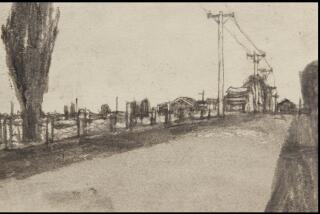Teen Graffiti Has Ancient Roots, Historian Says
- Share via
ANCHORAGE — R. Dale Guthrie sees Paleolithic art lifted from caves and makes a connection to 21st century walls -- the stalls of a junior high boys’ bathroom.
Some social anthropologists and art historians focus on the most detailed examples of prehistoric art and see symbols of religion or mysticism. But Guthrie studied thousands of more rudimentary drawings, the kind that never make it into coffee table art books. He saw images -- large animals, bloody spears, male sex organs, voluptuous women -- that reflect themes that have always preoccupied young boys and stimulated them to draw.
“They’re all naked,” he says of the female forms, with exaggerated breasts and hips.
He contends that a large fraction of Pleistocene art is the work of boys learning to find their way in their world, and evolving into adults.
Guthrie, a natural historian, sculptor and professor emeritus at the University of Alaska Fairbanks, lays out his contentions in a new book, “The Nature of Paleolithic Art,” published by the University of Chicago Press.
The theory has plenty of detractors.
French prehistorian Jean Clottes, coauthor of “The Shamans of Prehistory,” is a friend of Guthrie’s and is quoted on his book jacket. But he acknowledged that the theory was unlikely to be accepted by other scholars.
Clottes said in an e-mail that footprints show that children of all ages were present in the caves.
He also noted that next to elaborate cave drawings made by experts, often at heights that indicate they were made by adults, there are quite a number of doodles, marks on the walls and even crude drawings that children could do. But that they did so at play or for fun is an entirely different proposition, he said.
As for the subject matter, Clottes said, an interest in large animals, hunting and sex would not be confined to boys. “Does it mean that adult men are not interested in these subjects?”
The cave drawings and carvings are humans’ earliest preserved art, produced late in the Paleolithic period, which corresponds to the late Pleistocene Era, 10,000 to 40,000 years ago, across Europe and Asia.
It was a time when people lived in bands of 20 to 40 and women valued men for their protection and their hunting prowess, because a good hunter was the difference between survival and starvation.
Most books on Paleolithic art focus on the best of the era, images produced by highly skilled hands. Many scholars also contend that most of the art was done by shamans for religious purposes -- pictures to please the gods, or bless a hunt or dramatize a shaman’s vision.
Overlooked, Guthrie said, are thousands of less sophisticated drawings that he believes are of a more mundane origin. More than half the population was teenage or younger. With artistic tools available, Guthrie said, it’s highly likely youngsters painted too, and their work just as likely to be preserved as works by experienced hands.
Instead of photographs, Guthrie illustrated his book with his own line drawings of Paleolithic art. His renderings allow comparisons between paintings, carving and etchings and focus the eye away from artistic qualities toward content, he said.
Guthrie says he didn’t intend to focus on children but was forced to the conclusion.
He was struck by the consistency of images across thousands of years and square miles from Europe to Asia. Mammoths, cave bears, lions, bison and wild cattle abound. Hunting scenes show animals stuck with spears, blood flowing, and sometimes attacking the hunters.
It’s not graffiti, he says, but boys playing, drawing for fun, using pictures to learn how to become men, across prehistoric cultures stretching from what’s now Spain to Russia.
“You see the same things coming up over and over again, for a reason,” he said. “It’s their life.”
Many of the images are the kind of coarse, faceless pictures still drawn by 12-year-olds, not particularly erotic except to the young artist, Guthrie said.
More to Read
Sign up for Essential California
The most important California stories and recommendations in your inbox every morning.
You may occasionally receive promotional content from the Los Angeles Times.












